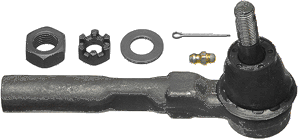Tie rods connect the component which translates the driver's intentions (most commonly this component is a rack & pinion) to the steering knuckle, which pivots on the ball joint. Typically, the tie rods are referred to as their two component parts, inner and outer tie rod ends. These two ends can be replaced seperately, and adjusted during alignments to correct the toe in/out.
Outer Tie Rod Ends
How to Replace Outer Tie Rod Ends
The outer tie rod end is held in place by a nut on the inner tie rod end, and a nut (ideally a castle nut) on the joint shaft. Both of these must be removed, starting with the nut on the nut on the inner tie rod end. Removing the nut on the joint shaft will allow the tie rod to move around much more, making the adjusting nut more difficult to remove.

The tie rod's ball-in-socket joint shaft can be pressed out with a specific tie rod end puller tool, but if there is no intention of reusing the old outer tie rod end, a hammer can be used to knock it out. Removing it with a hammer can damage the joint, and on some applications, may cause it to pop out and hit something else, so use best judgement.
When installing the outer tie rod on to the inner, some low or medium strength thread locker can be used to keep corrosion out, which will extend the life of both tie rods and it is easier to remove an outer tie rod later on when it has thread locking material on it instead of rust.
How to Replace Inner Tie Rod Ends
Inner tie rod ends are typically the longer of the two, with the threading on the outside of the shaft instead of inside the component. They screw on to the rack and pinion shaft towards the inside of the vehicle, and on the outside, the outer tie rod ends screw on. Replacing them usually requires a special tool to break them loose.
